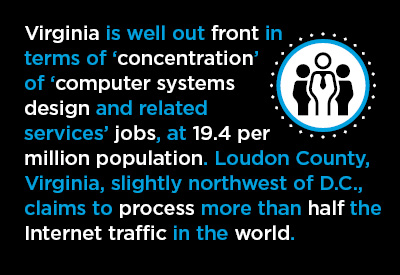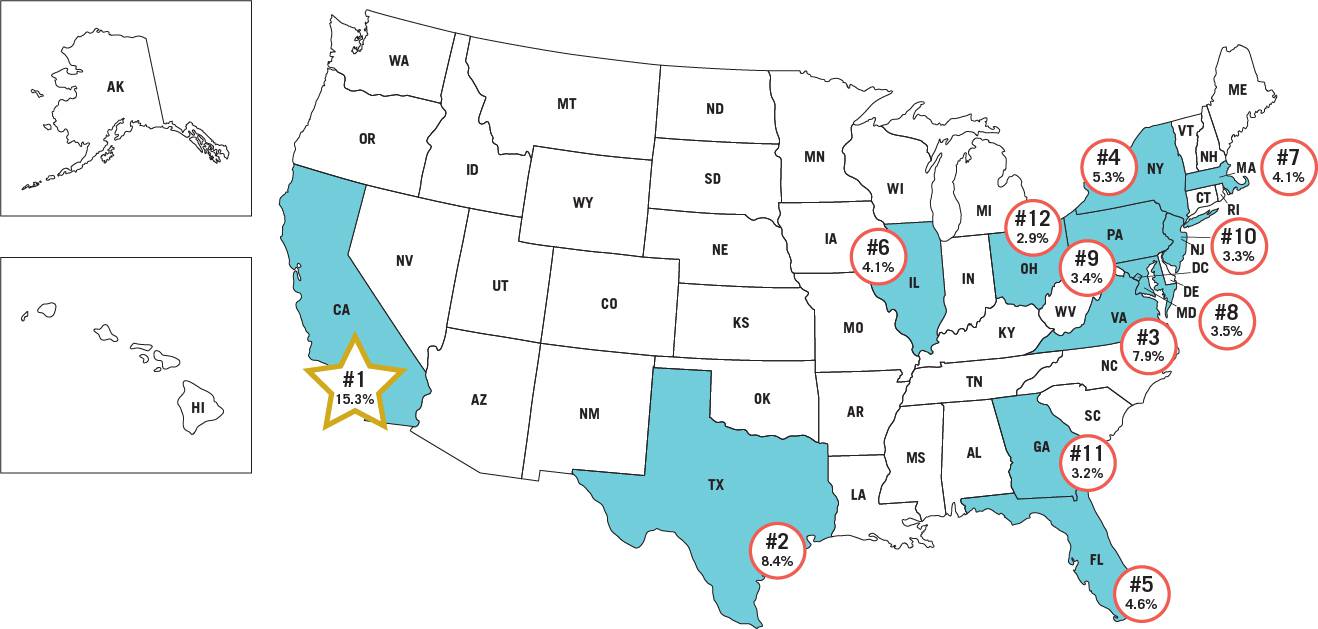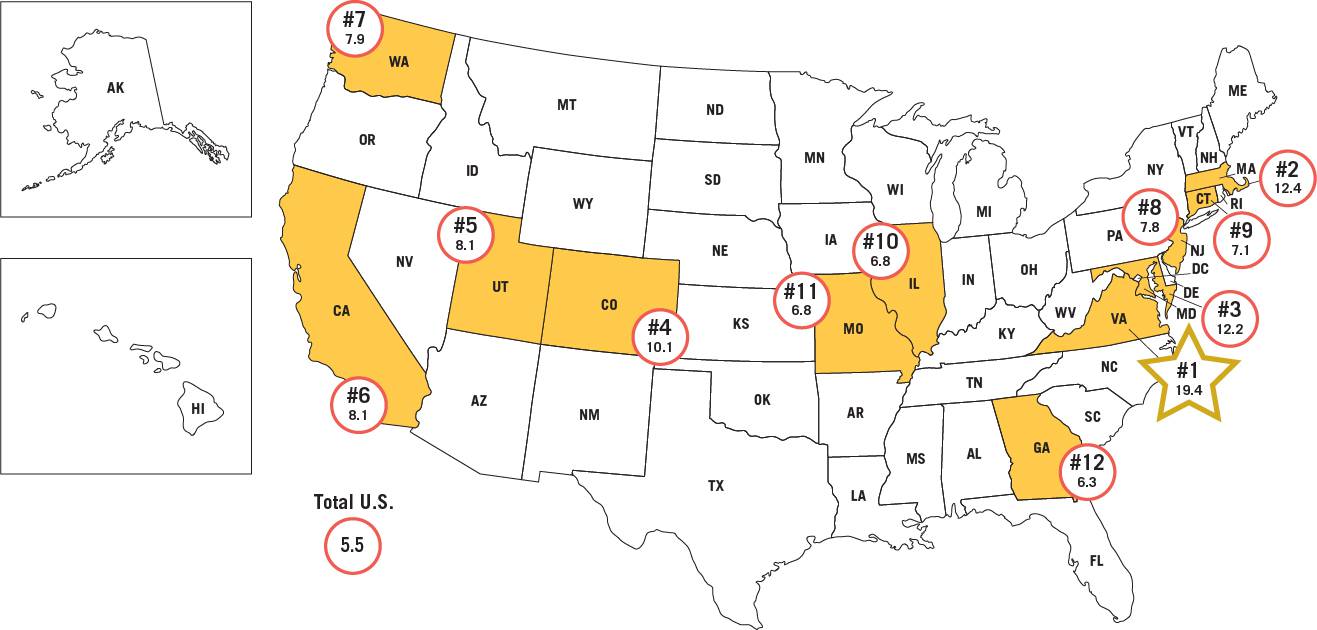Construction spending in various type-of structure categories is driven by economic circumstances within specific industrial subsectors. For example, manufacturers set the pace in industrial construction.

Good health in the leisure and hospitality sector provides the backing for new hotel and motel work. And jobs levels in information and financial services, as well as in more rapidly expanding fields of endeavor such as computer systems and design services, establish the need for additional office space and commercial tower square footage. (See, “Shifts in Office Jobs and Implications for Commercial Tower Construction“.)
This article is the fifth in a series of seven that examines key industrial sectors to determine where they are most prominent regionally. Rankings of state strength in each industrial sub-sector are based on both ‘weight’ and ‘concentration’ of relevant employment. ‘Weight’ is simply the number of jobs in the industrial sub-sector in each state. ‘Concentration’ is each state’s number of jobs in the sub-sector divided by the state’s population. In effect, it’s a ‘per capita’ figure, except that it’s expressed as number of jobs per million population.
By ‘weight’, the states with the largest populations are almost always high in the rankings. The rankings by ‘concentration’, however, often deliver a jolt of surprise or two.
State Tiers:
It’s important to know that three clear groupings of states emerge from an analysis of the Census Bureau’s latest (i.e., through July 1, 2018) population statistics. Those groupings are: (A) the four frontrunner states by nominal levels of population – California, Texas, Florida and New York; (B) the three states with the fastest year-over-year gains in population – Nevada, Idaho and Utah; and (C) another tier of six states with both strong nominal increases and percentage changes in resident counts over the past several years – Washington, North Carolina, Georgia, Arizona, Colorado and South Carolina. (See, “Latest State Population Statistics, Maps, & Tables – Six Dark Horse Winners“.)
Also read, “Series (1 of 7): Rankings of States by Industrial Subsector Jobs – Manufacturing“; “Series (2 of 7): Rankings of States by Industrial Subsector Jobs – Financial Services“; “Series (3 of 7): Rankings of States by Industrial Subsector Jobs – Information Services“; and “Series (4 of 7): Rankings of States by Industrial Subsector Jobs – Leisure and Hospitality“.
State Leaders in Computer Systems Design and Related Services Jobs – Highlights:
(1) ‘Computer systems design and related services’ jobs fall within the ‘professional and business services’ designation adopted by the Bureau of Labor Statistics (BLS). Acquiring the expertise needed to carry out such work warrants being called a ‘professional’. Furthermore, such employment is usually rewarded with a level of compensation above the ordinary.
(2) There are three sub-categories within ‘computer systems design and related services’ – (i) ‘custom computer programming services’; (ii) ‘computer systems design services’; and (iii) ‘computer facilities management services’. Payrolls in all three have been expanding rapidly, but it’s in (iii) where they have been especially taking flight. Companies have been increasingly moving their ‘big data’ to what are essentially ‘server farms’. Such facilities have come to be known as ‘the cloud’. And it’s in ‘the cloud’ where Virginia shines.
(3) The Internet sprang forth from efforts to facilitate the sharing of information by the Defense Department’s Advanced Research Projects Agency (DARPA), based in Pentagon City, Virginia. Hence, the state of Virginia had an early step up on the Web. Seizing the moment, legislators began offering tax incentives to private-sector firms to locate digital operations in the state. Loudon County, Virginia, slightly northwest of D.C., claims to process more than half the Internet traffic in the world.
(4) The city of Ashburn in Loudon County, Virginia, is ‘data center’ central. One concern that local residents tend to dwell on is the need for costly accompanying infrastructure. For powering up and keeping temperatures cool, data centers require enormous amounts of electricity.
(5) With respect to the ‘weight’ (i.e., nominal level) of jobs in ‘computer systems and design services’, Virginia has inserted itself between the four largest-population states. While its share (7.9%) of the U.S. total is well-below California’s (15.3%), it’s not far behind the portion held by Texas (8.4%); and Virginia solidly beats New York (5.3%) and Florida (4.6%).
(6) Virginia is well out front in terms of ‘concentration’ of ‘computer systems design and related services’ jobs, however, at 19.4 per million population. Massachusetts (12.4) and Maryland (12.2), in second and third places, trail by more than one-third. Maryland benefits from being in the same neighborhood as Virginia and D.C. Massachusetts sows ‘computer systems and design services jobs’ as a natural by-product of being home to several of America’s elite universities.
(7) Six of the 12 states that rank highly in ‘weight’ also appear among the Top Dozen for ‘concentration’ – California, Virginia, Massachusetts, Maryland, New Jersey and Georgia. From the ‘weight’ side of the table, California lays claim to nearly one in six of all ‘computer systems design and related services’ jobs in the U.S.
(8) One Tier B state (Utah) and three Tier C states (Colorado, Washington and Georgia) appear among the Top Dozen for ‘concentration’. Once again, this suggests a close correlation between desirable jobs, healthy population statistics and, ultimately, construction opportunities.
Map 1: Top 12 – Rankings of States by Industrial Subsector Jobs – “Weight”
Share of Total U.S. Computer Systems Design and Related Services Jobs

Data source: Bureau of Labor Statistics (BLS).
Graphic: ConstructConnect.
Map 2: Top 12 – Rankings of States by Industrial Subsector Jobs – “Concentration”
Computer Systems Design and Related Services Jobs Per Million Residents of the State

Total U.S. number of computer systems design and related services jobs per million population is 5.5.
Data source: Bureau of Labor Statistics (BLS).
Graphic: ConstructConnect.
Tables: Ranking of States by Computer Systems Design and Related Services Jobs
| Table 1: Weight: | Table 2: Concentration: | ||||||
| Share of Total U.S. | computer systems design and related services Jobs | ||||||
| computer systems design and related services Jobs | Per Million Residents of the State | ||||||
| 1 | California | 15.3% | 1 | Virginia | 19.4 | ||
| 2 | Texas | 8.4% | 2 | Massachusetts | 12.4 | ||
| 3 | Virginia | 7.9% | 3 | Maryland | 12.2 | ||
| 4 | New York | 5.3% | 4 | Colorado | 10.1 | ||
| 5 | Florida | 4.6% | 5 | Utah | 8.1 | ||
| 6 | Illinois | 4.1% | 6 | California | 8.1 | ||
| 7 | Massachusetts | 4.1% | 7 | Washington | 7.9 | ||
| 8 | Maryland | 3.5% | 8 | New Jersey | 7.8 | ||
| 9 | Pennsylvania | 3.4% | 9 | Connecticut | 7.1 | ||
| 10 | New Jersey | 3.3% | 10 | Illinois | 6.8 | ||
| 11 | Georgia | 3.2% | 11 | Missouri | 6.8 | ||
| 12 | Ohio | 2.9% | 12 | Georgia | 6.3 | ||
Total U.S. number of computer systems design and related services jobs per million population is 5.5.
Data source: Bureau of Labor Statistics (BLS).
Tables: ConstructConnect.











Recent Comments
comments for this post are closed